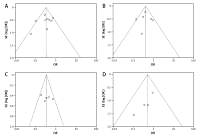Current issue
Archive
Manuscripts accepted
About the Journal
Editorial office
Editorial board
Section Editors
Abstracting and indexing
Subscription
Contact
Ethical standards and procedures
Most read articles
Instructions for authors
Article Processing Charge (APC)
Regulations of paying article processing charge (APC)
HEPATOLOGY / SYSTEMATIC REVIEW/META-ANALYSIS
Internal drainage versus external drainage in palliation of malignant biliary obstruction: a meta-analysis and systematic review
1
Medical School of Chinese PLA, Beijing, China
2
Department of Gastroenterology, Xingtai People’s Hospital, Xingtai, Hebei, China
3
Department of Gastroenterology and Hepatology, Chinese PLA General Hospital,
Beijing, China
Submission date: 2017-07-24
Final revision date: 2017-10-27
Acceptance date: 2017-11-02
Online publication date: 2020-04-06
Publication date: 2020-05-26
Arch Med Sci 2020;16(4):752-763
KEYWORDS
meta-analysisexternal drainagemalignant biliary obstructionpreoperative biliary drainageinternal drainage
TOPICS
ABSTRACT
Introduction:
Preoperative biliary drainage has been widely used to treat patients with malignant biliary obstruction. However, it is still unclear which method is more effective: internal drainage or external drainage. Thus, we carried out a meta-analysis to compare the safety and efficacy of the two drainage methods in treatment of malignant biliary obstruction in terms of preoperative and postoperative complications.
Material and methods:
We conducted a literature search of Medline, EMBASE, PubMed, Ovid journals and the Cochrane Library, and compared internal drainage and external drainage in malignant biliary obstruction patients. The pre- and postoperative complications, stent dysfunction rate and mortality were analyzed.
Results:
Ten published studies (n = 1464 patients) were included in this meta-analysis. We found that patients with malignant biliary obstruction who received external drainage showed reductions in the preoperative cholangitis rate (OR = 0.33, 95% CI: 0.24–0.44, p < 0.00001), the incidence of stent dysfunction (OR = 0.41, 95% CI: 0.30–0.57, p < 0.00001), and total morbidity (OR = 0.34, 95% CI: 0.23–0.50, p < 0.00001) compared with patients who received internal drainage.
Conclusions:
The current meta-analysis indicates that external drainage is better than internal drainage for malignant biliary obstruction in terms of the preoperative cholangitis rate, the incidence of stent dysfunction and total morbidity, etc. However, the findings need to be confirmed by randomized controlled trials.
Preoperative biliary drainage has been widely used to treat patients with malignant biliary obstruction. However, it is still unclear which method is more effective: internal drainage or external drainage. Thus, we carried out a meta-analysis to compare the safety and efficacy of the two drainage methods in treatment of malignant biliary obstruction in terms of preoperative and postoperative complications.
Material and methods:
We conducted a literature search of Medline, EMBASE, PubMed, Ovid journals and the Cochrane Library, and compared internal drainage and external drainage in malignant biliary obstruction patients. The pre- and postoperative complications, stent dysfunction rate and mortality were analyzed.
Results:
Ten published studies (n = 1464 patients) were included in this meta-analysis. We found that patients with malignant biliary obstruction who received external drainage showed reductions in the preoperative cholangitis rate (OR = 0.33, 95% CI: 0.24–0.44, p < 0.00001), the incidence of stent dysfunction (OR = 0.41, 95% CI: 0.30–0.57, p < 0.00001), and total morbidity (OR = 0.34, 95% CI: 0.23–0.50, p < 0.00001) compared with patients who received internal drainage.
Conclusions:
The current meta-analysis indicates that external drainage is better than internal drainage for malignant biliary obstruction in terms of the preoperative cholangitis rate, the incidence of stent dysfunction and total morbidity, etc. However, the findings need to be confirmed by randomized controlled trials.
Share
RELATED ARTICLE
We process personal data collected when visiting the website. The function of obtaining information about users and their behavior is carried out by voluntarily entered information in forms and saving cookies in end devices. Data, including cookies, are used to provide services, improve the user experience and to analyze the traffic in accordance with the Privacy policy. Data are also collected and processed by Google Analytics tool (more).
You can change cookies settings in your browser. Restricted use of cookies in the browser configuration may affect some functionalities of the website.
You can change cookies settings in your browser. Restricted use of cookies in the browser configuration may affect some functionalities of the website.



